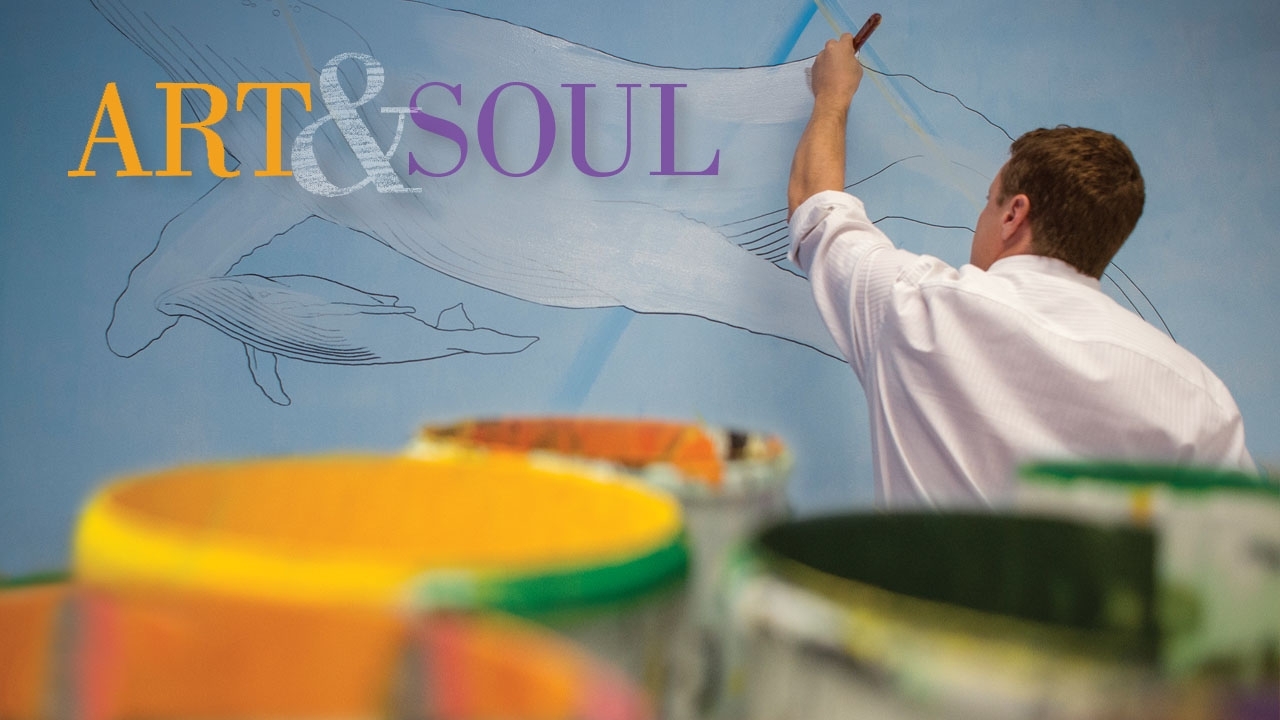Hospitals are not immune to magic.
When Elizabeth Vander Kamp begins telling a story to an elderly woman at UAB Hospital-Highlands one Thursday morning, the room vanishes, revealing a forest where a steadfast princess tries to melt the heart of her cruel father. After a series of trials, the heroine emerges triumphant in the end—and so does the patient, who beams with delight from her bed and asks Vander Kamp when she can come back to tell another tale.
Vander Kamp will most definitely be back. As an artist-in-residence with UAB’s new Institute for Arts in Medicine (AIM), she spends several days a week visiting patients in the Acute Care for Elders (ACE) and Bone Marrow Transplant (BMT) units. There, the vivacious actress tells heartening stories—along with the occasional bad joke, she says—to patients. She considers herself a “story gardener”: “By offering a story, I lay fertile ground for others to tell their own stories,” she explains.
The words they share are designed to heal—by helping patients to laugh and talk, to overcome pain and fear, to awaken their imaginations, to revel in the possibility of happy endings.
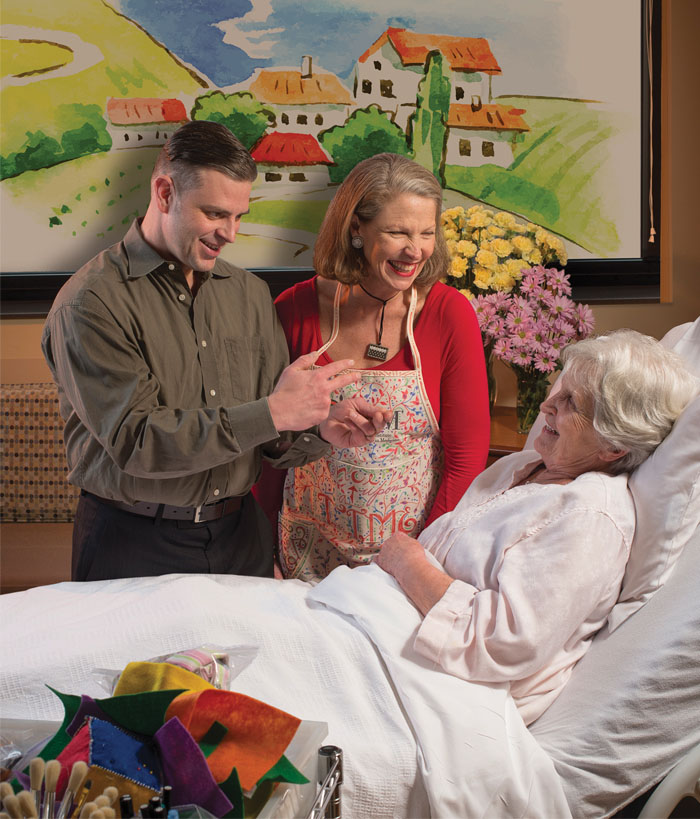 Artists-in-residence David Roby and Elizabeth Vander Kamp take UAB patients on imaginative journeys through their storytelling.
Artists-in-residence David Roby and Elizabeth Vander Kamp take UAB patients on imaginative journeys through their storytelling.
The Creative Treatment
About half of American hospitals have some form of arts programming. Most take the form of art or music therapy, where trained professionals work with patients to achieve specific therapeutic goals. (UAB Hospital has had a music therapy program for about 15 years.) But a growing number of medical centers—UAB Hospital is the first in Alabama—also are implementing the more comprehensive AIM model.
UAB’s six artists-in-residence—actors, a playwright, a sculptor, a painter, a textile artist, and a dancer—“provide creative experiences and positive distractions,” explains Kimberly Kirklin, AIM’s director of programming. “These might include a patient making a piece of art or participating in an arts activity, or simply enjoying a performance.” Such moments of inspiration and engagement can benefit patients both physically and mentally—and work wonders for their spirit.
“This brings to UAB Medicine the side of healing that isn’t science,” says Jordan DeMoss, senior associate vice president for UAB Hospital. He dreamed up the concept for the program a few years ago, and, following UAB’s long tradition of interdisciplinary collaboration, reached out across the campus to the Alys Stephens Performing Arts Center (ASC).
Through its ArtPlay education and outreach program, the ASC had cultivated a community of local artists eager to share their talents. Some already had conducted performances and workshops in local hospitals and assisted-living centers through the ASC’s ArtCare initiative. The experience had demonstrated the “tremendous power of the arts to transform lives and improve the human condition,” says Theresa Harper Bruno, ASC corporate board chair, president of THB Inc., and co-chair of The Campaign for UAB. “The arts feed the emotional well-being of patients.”
The new partnership won the immediate backing of UAB President Ray L. Watts, M.D.; UAB Health System CEO Will Ferniany, Ph.D.; and UAB Senior Vice President Shirley Salloway Kahn, Ph.D., who oversees development, alumni, and external relations, for its fresh approach to delivering high-quality care and patient satisfaction. With their financial support and belief in AIM’s vision, plus a pilot grant from UAB Medicine’s Innovation Board, which provides resources to test new ideas, the program launched in 2013. Currently, the artists-in-residence rotate through a few specific hospital units each week, but any inpatient can request an artist visit or art supplies. Families of patients are welcome to join the fun as well.
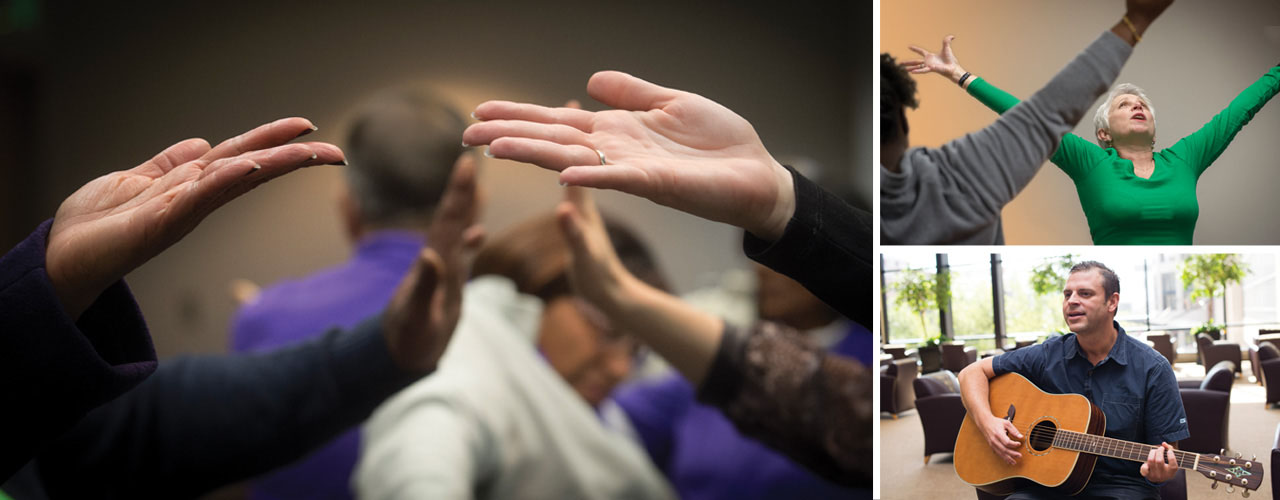 (Left and top right) Melissa Turnage's movement class lifts limbs and spirits. (Bottom right) Roby sets some of his stories to music.
(Left and top right) Melissa Turnage's movement class lifts limbs and spirits. (Bottom right) Roby sets some of his stories to music.
Dance It Out
UAB’s adolescent psychiatry unit is a highly charged—and highly challenging—place. The 12- to 18-year-old patients have severe, chronic illnesses that can involve post-traumatic stress, anxiety, or depression. But each week, artist-in-residence Melissa Turnage turns on some music and teaches these teenagers how to dance—ballet, jazz, or freestyle.
The effect on the patients “is a joy to see,” says Marion Wallace, Ph.D., assistant professor of child and adolescent psychiatry and clinical director of the Alabama Department of Mental Health unit at UAB Hospital. “Their faces are so bright. You see them smile. They look forward to it.”
A block away, UAB’s BMT unit cares for patients fighting multiple myeloma, lymphoma, leukemia, and some solid tumors. Their rooms are open and airy, with large windows, but after a few weeks, some patients feel as if they’re in a cave, says nurse manager Wendy Madden, R.N., M.S.N. Pain from chemotherapy and depression are common. “They’re facing cancer, and they know what the outcome can be,” Madden says.
She recalls one depressed patient who didn’t want to eat or get out of bed—putting her at risk for pneumonia and other conditions. Heeding Madden’s call, Vander Kamp offered the patient a little escape through the entertaining tale of a girl with long, flowing hair. “I saw a transformation as the patient watched Elizabeth,” Madden says. “She had a little smile on her face, and when we left the room, she didn’t ask us to turn off the lights.”
Those smiles illuminate AIM’s deeper benefits. Research at other medical centers has indicated that arts programs may boost the moods of patients and their families by reducing perceived pain, anxiety, and stress. In turn, that could contribute to a reduction in medication use, a quicker recovery, and a shorter hospital stay.
“We know that AIM is the right thing to do for our patients,” DeMoss says. “The arts have thrived for thousands of years, which is proof enough that they are beneficial and therapeutic.”
Wallace agrees. “We use evidence-based treatments for our patients, but we’re also bringing in things that are intuitive; they just work,” she says. “We know we feel better after we hear a good song or paint something that inspires us. It boosts our self-confidence and self-efficacy.
“Sometimes our patients aren’t at a point where they can speak about traumatic experiences in a therapy session because it’s too distressing,” she adds, “but they can dance to some music and express their feelings that way.”
“It’s a compassionate, effective method of treating our patients’ pain and depression without giving them another pill,” Madden says.
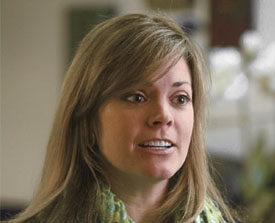 Kimberly Kirklin
Kimberly Kirklin
Tale As Old As Time
Merging the arts with medicine might seem like a 21st-century concept, but its roots stretch back to the beginning of human history, says Kirklin. "Dance and visual art have always been part of traditional healing practices," she explains. The fine line separating physicians and artists began to widen only a few centuries ago, when scientific discoveries about germs led to hospitals becoming more sterile, separate environments. Now, with medical centers shifting to a "whole-person" approach to treatment, "it's become very clear that the arts do have a place," Kirklin says. "It brings the soul back to medicine."
Infusions of Imagination
When textile artist Lillis Taylor rolls her art cart, overflowing with colorful fabric and thread, into the High-Risk Obstetrics unit in UAB’s Women and Infants Center, “it starts a conversation,” she says. Before too long, you could mistake the unit for an old-fashioned quilting bee. “It’s exciting to talk to the mothers—and sometimes the fathers—about the hopes and dreams they have for the baby that’s coming. They want to make something so that their child knows they were excited about his or her arrival.”
The act of putting stitches in fabric also serves another purpose on this unit, where anxiety can run high among expectant mothers worried about the health of their unborn babies. “It’s very meditative,” Taylor says. “It provides a single focus. The women really take ownership of their projects, and sometimes they continue working on them when they go home.”
The gentle, positive impact of the arts on patients and families has not been lost on UAB Hospital’s clinical staff, who have welcomed AIM with open arms. The program “is one of the greatest things to happen to our unit,” says Terri Middlebrooks, R.N., clinical care coordinator for the nationally renowned ACE unit. She and her staff care for patients 65 and older—the oldest was 112—with a focus on mobility and cognitive stimulation to help them maintain function and quality of life. Some patients stay on the unit for extended periods; many have dementia. For these elderly patients, AIM is a perfect fit, Middlebrooks says.
“Our patients need people to talk with them; they want to tell their stories,” she says. Vander Kamp and actor/playwright David Roby are ready to listen. Sometimes the artists go first, reciting a poem, retelling a legend, or acting out a Shakespeare monologue. When the patients begin sharing true stories from their own lives, Roby helps them write mini memoirs to preserve those precious words for their families. If the patients aren’t able to write, he often does it himself. “Otherwise, these stories would be lost,” Roby says. “They might say something about themselves or their lives that their families might not know.” Sharing their stories can also feel uplifting and cleansing, he adds.
Middlebrooks has watched her patients smile, eat better, and “come alive” after visits from the storytellers and visual artists. (The ACE patients especially enjoyed coloring with crayons, she says.) She has even seen improvements in patients with memory problems. The artists-in-residence play such a vital role in the unit that they have even become part of the ACE care team, participating in rounds meetings where clinicians review the status of each patient.
“Terri will say, please go see this patient—he would really enjoy a visit from you—or go see this person because she seems particularly down today,” Vander Kamp says. By getting to know each patient, Vander Kamp and the other artists can also provide clinical staff with valuable observations and insights that can enhance care.
Wallace has even tweaked her own approaches to patient therapy sessions after watching the artists work. “Before AIM, I would start with cognitive skills or behavior reversals,” she says. “Now I begin by asking the patients if they want to listen to music or show me the dance steps they learned. I don’t think we, as staff, previously understood how calming and soothing the arts can be.”
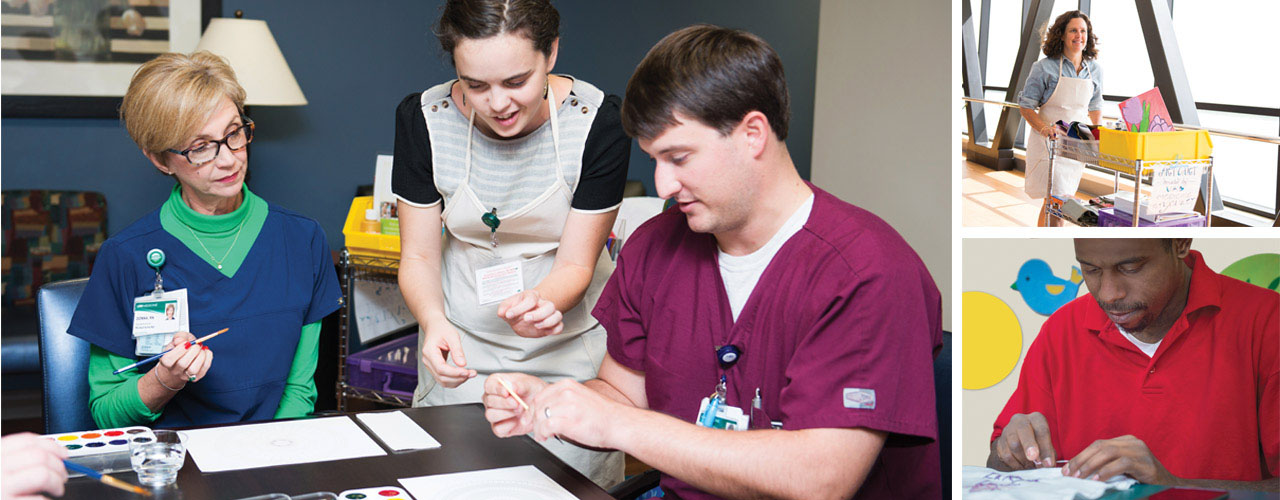 (Clockwise from left) Lillis Taylor leads a stress-relieving class for clinical staff; Visual artist Helene Taylor brings an art cart to a patient; an expectant father sews a gift for his child.
(Clockwise from left) Lillis Taylor leads a stress-relieving class for clinical staff; Visual artist Helene Taylor brings an art cart to a patient; an expectant father sews a gift for his child.
Painting Away the Stress
What calms and soothes the patient also applies to physicians, nurses, and other clinical staff, who often need some time to heal from the emotion and stress of each day’s work. For them, the artists-in-residence offer classes in painting, calligraphy, and movement. Staff can even request one-on-one storytelling.
“Our staff care deeply about our patients, and to see them suffering and struggling is difficult,” DeMoss explains. Through AIM, they can take a moment to relax, shift their focus, and share difficult experiences with other members of their care teams. “It helps them to be better providers, and it helps them sustain a career in health care,” DeMoss says.
“If we’re having a stressful day, we can do 20 minutes of yoga before dance starts, or we can do finger painting with the patients or learn the ‘Thriller’ dance with them,” Wallace says. In her unit, these activities can ease the staff’s tension in another way: “It helps our relationships with the patients,” she says. “We set limits and boundaries, and they test those; it can become antagonistic. But we can have fun together in dance. It changes the culture of the unit.”
The caregivers look forward to seeing the artists as much as the patients do, Middlebrooks says, and some staff even carry the creative spark home. Wallace now practices dance steps and is experimenting with painting in her free time. Middlebrooks dreams of becoming an actress “in my next life” and may sign up for Roby’s acting class at ArtPlay. “The artists move me,” Middlebrooks says. “I want to do what they do.”
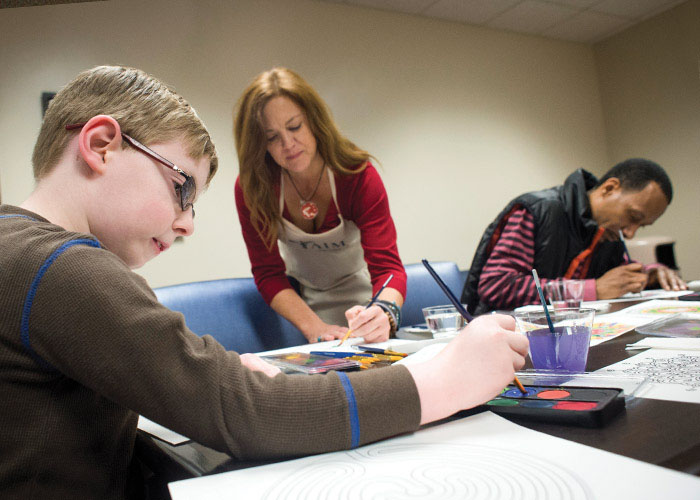 Visual artist Kim McKenzie (center) inspires family members of patients in the Heart and Lung Transplant Intensive Care Unit waiting area.
Visual artist Kim McKenzie (center) inspires family members of patients in the Heart and Lung Transplant Intensive Care Unit waiting area.
Performance-Based Medicine
AIM’s story at UAB Medicine is just beginning. Plans call for adding artists—perhaps a musician and more visual artists—to meet the growing demand from current units and to reach new inpatients, outpatients, families, and staff throughout the hospital each year. Public performances could help the sights and sounds flow into lobbies, waiting areas, and main thoroughfares throughout the medical center. Gallery exhibits in the hospital, featuring works by local artists, also are a possibility.
Naturally, funding AIM is a challenge, particularly with the financial shifts that health systems have been facing. Community support, including donations and sponsorships, could supplement UAB funds to expand a program that pays dividends far above and beyond its budget, DeMoss says. “I want AIM to be in every part of UAB’s care experience”—as ubiquitous as the televisions throughout the hospital and clinics, he explains. “We don’t think twice about investing in those TVs. We should also invest in a program that’s meaningful and engaging for patients and families—and healing them in a whole other way.”
With philanthropic support, the arts have greater potential to change the lives of people suffering from illness, disease, and other medical conditions, Bruno adds. “AIM can reach heights that we haven’t imagined yet.” The artists-in-residence are eager to imagine that future. They’re ready to tell—and write—more stories, paint more pictures, bust more moves, and put all of their creativity to work to help patients feel better.
“We need to treat the illness, but we also need to address that there’s a human being sitting here, pacing, anxious, terrified, and annoyed,” Taylor says. Art has a unique power to alleviate those feelings, she adds.
“Art is very much a part of our hearts, our lives, our souls, our vitality.”
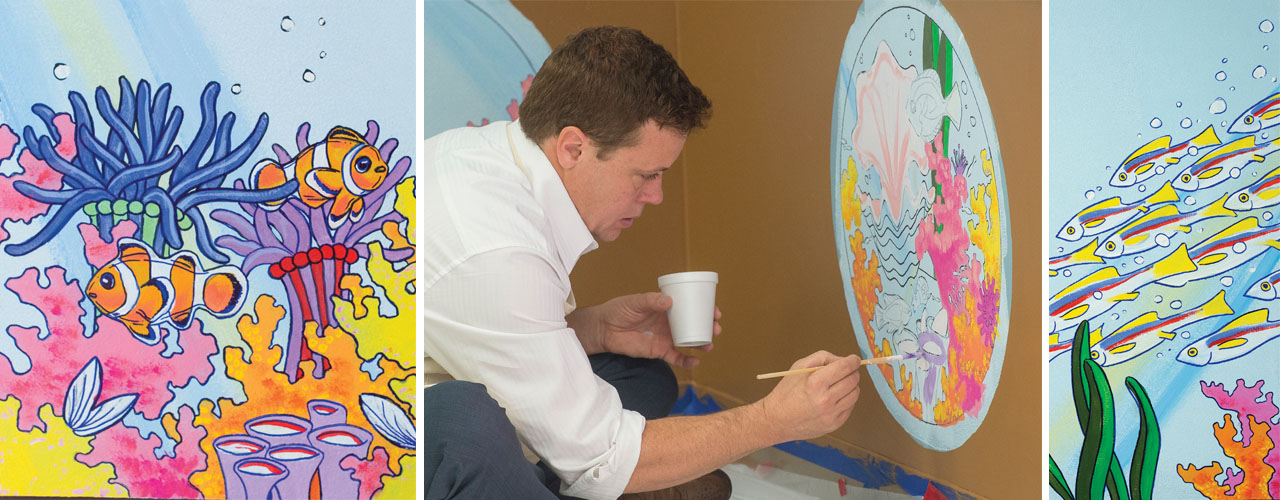 Wallace's adolescent psychiatry patients guided the creation of a mural painted by ASC technical director Adam Stermer (center photo and top of page) and other AIM artists—from selecting the undersea theme to offering a thumbs-up through a window as work progressed. "We wanted our space to feel more homelike and comfortable for our patients and their families," Wallace says. The colorful scene now brightens the atmosphere along with patients' moods, she adds.
Wallace's adolescent psychiatry patients guided the creation of a mural painted by ASC technical director Adam Stermer (center photo and top of page) and other AIM artists—from selecting the undersea theme to offering a thumbs-up through a window as work progressed. "We wanted our space to feel more homelike and comfortable for our patients and their families," Wallace says. The colorful scene now brightens the atmosphere along with patients' moods, she adds.
AIM in Action
Artists and clinical staff share a few of their most inspiring experiences
Positive Steps: When Wallace suggested Turnage’s dance class to a defiant 18-year-old male patient who constantly made sexually inappropriate comments and gestures, he was resistant. But after observing for a while, he felt more comfortable and eventually began participating. It turns out that “he really had a knack for dance,” Wallace says. “He picked up on the moves easily, and Melissa cultivated that. Once he realized he had a talent that could get positive attention, he didn’t make as many inappropriate comments, and he no longer threatened us,” she says. “Instead of him shouting obscenities when we walked past his room, we would see him practicing moves he had learned.”
Vanishing Act: Roby and Vander Kamp have performed for packed theaters, but as artists-in-residence, they typically act for an audience of one—or maybe two or three, if family members are present. But that’s not the only adjustment they must make in bringing their art to the hospital. Sometimes their audience wants them to go away entirely. And the actors are OK with that. “One of the most important things about AIM is that patients have the power to say no,” Vander Kamp explains. “There’s so much they can’t say no to in the hospital, and we respect that it’s their room and their time. “I’ve gotten some of the most beautiful no’s I’ve ever received,” she adds.
Moving Moment: One day, as Vander Kamp’s movement class was about to begin, she saw a group of new nursing students gathered nearby and invited them to join her. “All 25 of them—in their aqua scrubs, white jackets, and white sneakers—formed a circle, holding hands, and moved together,” Vander Kamp says. “It was so beautiful. They were giggling, and I hope it fostered a camaraderie that they continue to enjoy.”
Healing Art: After Taylor taught a grandmother to quilt, the woman began making a blanket for her granddaughter, who had been in the neonatal intensive care unit since birth. Each flower-shaped block she added had a specific meaning. “She used a piece from the shirt her granddaughter wore during her first surgery,” Taylor says. “She made a Halloween flower. She wanted her granddaughter to know about the things she was missing.” Sadly, the baby passed away, but the grandmother continues to work on the quilt as a memorial. “Now it will tell the story of her granddaughter’s six months of life,” Taylor says.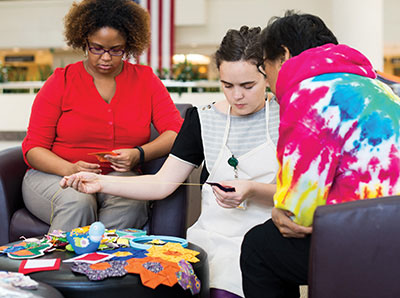 Taylor introduces the art of quilting to patients and families in UAB's Women and Infants Center.
Taylor introduces the art of quilting to patients and families in UAB's Women and Infants Center.
• Learn more about UAB's Institute for Arts in Medicine.
• Become a volunteer with AIM.
• Give something and change everything for patients, families, and caregivers with a gift to AIM.
